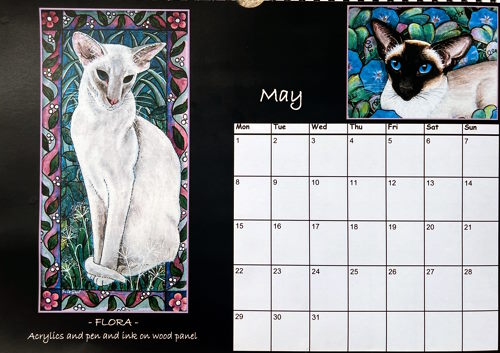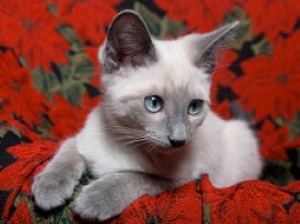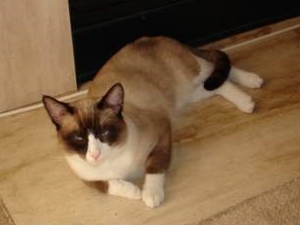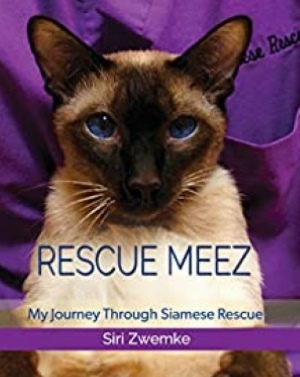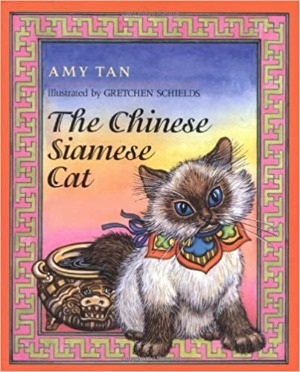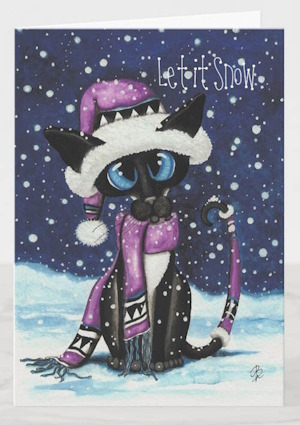- Home
- Meezer Musings
- May 2023
Meezer Musings: May 2023
What Kind of Cat Am I?
Welcome to May's Meezer Musings! I know we're nearly into June and the summer months, but I thought we'd start with May's page from Suzanne Le Good's Siamese cat calendar, because it's so pretty and springlike.
Suzanne's calendars are always a delight - sadly, they're sold out for 2023 but if you aren't already a devotee, do make a note to buy one next year! More of Suzanne's artwork - prints, cards and gifts - are available from Suzanne's Gallery on Etsy.
Brothers From Another Mother? No!
This month, inspired by a question on our Facebook page (are Ragdolls related to Siamese cats?) we're taking a look at two cat breeds that might at first glance be confused with Siamese cats.
These are the Ragdoll and Birman cat breeds, both of which are long-haired. (This is our first clue that these are not Siamese cats, which of course have short hair.) However, in some cases, they do have similar coloring - blue eyes and a 'pointed' coat pattern - comprising the darker face, ears, paws and tail with which we, as Siamese cat owners, are all very familiar.
I'm also including a short note towards the end of the page about Snowshoe cats, which were developed out of the Siamese breed.
But first ...
A Short Genetics Lesson
The gene responsible for the blue eyes and pointed coat pattern we all know and love is the 'cs' gene, also known as the 'Himalayan' gene. This gene is heat
sensitive, meaning that it produces different colors based on temperature variations in different areas of a cat's body.
Cooler parts of the body, in particular the extremities - ears, face, legs, and tail, produce darker colors, while the warmer areas in central parts of the body produce lighter ones.
This gene is found in a number of different cat breeds, and also specific varieties of rabbits and mice!
The Ragdoll Cat Breed
As you'll see from the picture below, Ragdolls share the blue eyes of Siamese cats and in some cases their pointed coat pattern. I say 'in some cases' because Ragdolls come in a variety of colors and patterns. As well as the pointed variety below, which is called Colorpoint, there are two others - Mitted and Bi-color.
You can find out more about all three of them on our Ragdoll cat breed page.
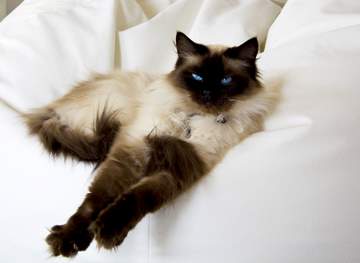 Seal Colorpoint Ragdoll
Seal Colorpoint RagdollImage © iStockphoto | Daniel Käfer
Ragdolls tend to be large, muscular cats, generally bigger than Siamese, with long silky hair and plush coats.
By nature they're gentle,
relaxed, laid-back cats, with a tendency to go limp when picked up -
leading to their name, Ragdoll. Apparently this 'floppy' tendency is due to a genetic mutation that means that these cats are less able to tense their muscles than other breeds.
Like Siamese cats, Ragdolls are intelligent and learn quickly, but unlike Siamese cats, they aren't very vocal; they tend to communicate through body language rather than using their voices.
The breed originated in California in the 1960s, when a breeder called Ann Baker bred a white Persian cat, named Josephine, with a Birman. The result was a litter of kittens with a unique temperament and appearance, and Josephine's offspring became the foundation for the Ragdoll breed.
So Ragdoll origins include the Persian cat breed (which also lent its genes to Himalayan cats) and the Birman cat breed.
So let's take a look at Birmans ...
The Sacred Cat of Burma
The Birman cat breed's beginnings are mysterious but it is known that the breed originated in Burma, now Myanmar. The English name for the breed comes from the French 'Sacré de Birmanie', meaning Sacred Cat of Burma.
Birmans are medium to large cats; gentle, affectionate and playful. As noted above, they are long-haired, with long, silky fur that needs regular grooming.
Like Siamese cats, they have bright blue eyes and a pointed coat pattern in the four main point colors of seal, blue, chocolate and lilac. Birmans, though, are particularly known for their white feet, as you can see in the picture below.
These white 'gloves' or 'socks' are due to the presence of a gene (the cb gene) which produces white areas on the cat's fur. In Birmans, the cb gene is expressed in a unique way, causing the white areas to be limited to the paws, with the rest of the fur being a darker color.
Birmans are also known for having a 'golden' aura and you can see an example of this, and find out more about the breed, on our Birman cat breed page.
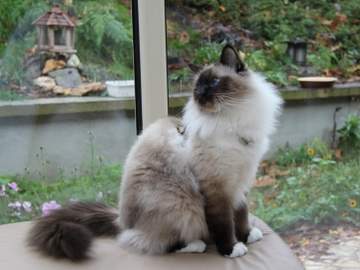 Seal point Birman showing white feet
Seal point Birman showing white feetImage © iStockphoto | Isabelle Mo
A Note About Snowshoes
While we're on the subject of 'breeds that aren't Siamese' I'm including here a short note about the Snowshoe cat breed, which was developed from the Siamese breed.
Snowshoes are short-haired cats which (as their name suggests) have white feet and also, notably, an inverted white 'V' on their face and nose. You can find out more about them here, but here's Champion Snowshoe Mr Slinky - a perfect example of the breed.
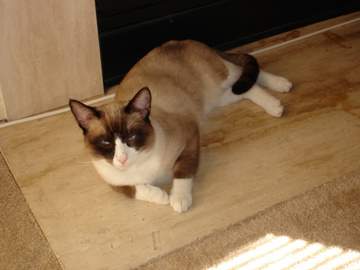 Champion Snowshoe Mr Slinky
Champion Snowshoe Mr SlinkyImage © Cooseman22 at the English Wikipedia project
For Our Facebook Followers
For those of you who follow our Facebook page (thank you!) I'm including a note here to talk about spam posts, which are sadly on the increase.
Our Facebook page has been receiving two kinds of spam, which are usually posted in response to genuine comments made by visitors to the page.
The first is from people posting links to groups purporting to sell kittens (very much not allowed under Facebook's Terms & Conditions). The second is from people asking you to 'friend' them or send them a message.
Please don't interact with either of these types of posts in any way! I report, ban, and hide or delete these posts when I see them, but I'm not always able to catch them immediately.
If you see them, don't respond, or, as they say, "please don't feed the trolls"!
Tail End ... and an Appeal
I don't often share fundraising appeals through Meezer Musings, but I particularly wanted to include this one. I'm sure you'll understand why.
There's an account I've followed on Twitter for some time - Lyndel, Max, Luke and Sam - run by an opera
singer, Miranda, who lives with her husband and four cats, three of which (Max, Luke and Sam) are Siamese. I've always enjoyed following their adventures, particularly as the cats have a lovely garden to play in, securely enclosed with cat-proof fencing.
Recently it's been discovered that Miranda's husband Andy has severe lung fibrosis, needing a lung transplant and months of tests, treatments and surgery.
A GoFundMe fundraising account has been set to help the couple and anything you can spare would mean the world to them as they face this enormous and terrifying challenge in their lives.
The cats, I'm sure, would appreciate your support as well.
 Max, Luke and Sam
Max, Luke and SamImage © copyright Miranda Keys
That's all from me for this month, but I hope to be back at the end of June. I say 'hope to be' as my husband is also having some much-needed surgery soon, and my writing time may be rather restricted.
But if not June, then I'll be back at the end of July, and I hope you and your cats are enjoying the longer days, warmth and sunshine as we head into the summer.
Caroline
Missed a Meezer Musings? A list of previous newsletters can be found here.
Some of the articles and newsletters on this site may contain links to products I think you may enjoy. If
you purchase through these links I receive a small commission, but there's
no extra cost to you. Find out more on the Affiliates Disclosure page.
Have You Discovered Our Newsletter?
If not, why not? Subscribe to our email newsletter, Meezer Musings, to stay in touch, be the first to see new information and pages as they come out, and read the things we only talk about in the newsletter.
Learn more about it on our Newsletter Sign-Up page.
